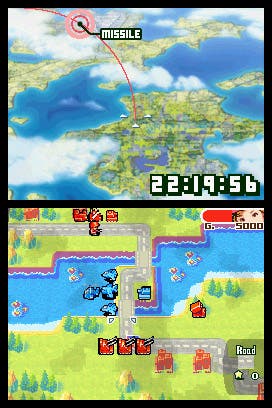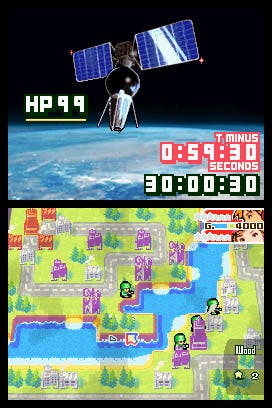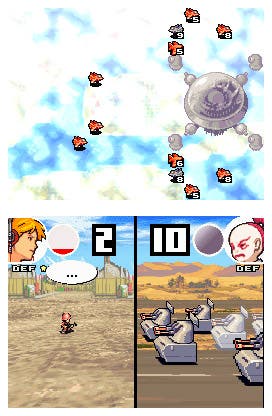Advance Wars: Dual Strike
A must-buy handheld classic.
Being yet another game to shoehorn a DS-related subtitle into its name, Advance Wars: Dual Strike once again sets out to prove that two screens are, indeed, better than one. But is it really the great, er, Advance we're all hoping for, or another dead-eyed attempt by Nintendo to get us to part with our hard-earned cash in an effort to play the same game on another handheld? Could Intelligent Systems really bring more to the game than had previously been achieved on GBA without ruining the essence that made Advance Wars such an essential offering in the first place?
Short answer? Damned Straight it does.
Dual Strike not only makes clever use of the DS, but beefs up the content while maintaining the ease, simplicity and out-and-out compelling gameplay that previous versions delivered in spades. If you thought either of the previous two versions were good, then it's probably best to acknowledge from the off that the best part of the next few months of your life will be lost to the third handheld incarnation of the classic turn-based strategy masterpiece. It's definitely one of those games.
For the benefit of those of you unfortunate enough to have missed out on the previous classics in Advance Wars series (and the dreadful UK sales figures suggest that's most of you), it's like a genius reincarnation of chess, except you get to move all the pieces (tanks, artillery, infantry, planes, ships, you name it) on the battlefield in one turn. That said, it's better than beardy old chess because you get all of the contemplative lip-biting strategy of mastering your approach and attack, while also getting to see how more than one movement affects the status of the game. Every choice you make counts, from your CO's (Commanding Officer's) strengths and weaknesses to your enemy's foibles. You're in control and each decision can potentially swing the stakes back into your favour, or hand advantages to the opposition.

In previous Advance Wars, we met Nell, a happy and chirpy CO with great foresight and the charm of an air stewardess, not to mention the uniform (the only clothes she possesses, it seems), but this time around we're guided by Rachel (Nell's younger sister) who introduces us to the other newer COs - like skater yoof Jake, or our enemy Kindle, the vain luvvie working for the nefarious Von Bolt (the desert-craving old dude with a bad case of asthma). Mix Stephen Hawking and A Team brain candy, then imagine that motley crew were your opposition
Enough about the playground jollities of the slightly throwaway plot and their cartoon antics - where does the dual screen come into play? Simply, the bottom touch screen is the main arena, and where you play out each primary mission. You can use the stylus to move your units if you like, but it's arguably quicker, easier, and more accurate to carry on using the old fashioned d-pad/buttons combination as before. Controlling each unit with an effortless tap of the thumb is still a more reliable and speedy means of commanding your units that drawing wiggly lines on screen - but hey, it's there. Some may prefer using the stylus, but it just seemed like a novelty to us.
The top screen, meanwhile, offers an additional sub plot to most missions. If you like, you can control all the action on both screens of the DS, though you don't have to - for an easier and quicker game you can leave the top screen on auto and watch events unfold between your turns. If anything it just adds another dimension to each mission, but at times it can be a bit tedious waiting for the secondary front to re-jig itself before each day is over. On the other hand, if your COs succeed in completing their task on the top screen, they can come and help you battle things out on the primary front afterwards. Before the end of each day (or turn) you have the opportunity to swap over your COs - which seemed initially like some sort of pointless job share arrangement. But, as it happens, it's a good aspect of the game because you get to apply the merits of two COs, rather than just one. If you lose though, watch out: the enemy will be able to perform a CO swap instead and this advantage places the winner in a much stronger position.

Continuing this new 'Dual Strike' emphasis, if you're lucky enough to have two of them available on the same mission and can manage to get them both up to super power, you are given the option to tag. This means that you get to blast the enemy with your CO super power, take a turn, then change to the next CO, use their super power and take another turn - in effect moving twice. This is handy for a multitude of reasons, such as attacking and retreating, getting closer to the enemy HQ, or simply capturing buildings and bases, which normally take two turns to master. In tagging mode you are under the least amount of threat from the enemy, because not only do you bombard the enemy with all your strengths; you also have the luxury of two days' worth of movement and attack time counted as only one. It really is a great feature because it makes you concentrate on the characteristics of the opposition much more than the previous games ever did.
Another new element is the Combat Mode; a simple real-time shooter version of the traditional game, where you move one unit around at a time and try to duke it out with the other units busy scurrying around on screen. Essentially the objectives and rules are exactly the same, but you move around (with the d-pad) to capture the enemy headquarters while dodging bullets. It's something Advance Wars veterans won't be used to seeing on the maps - bullets flying, that is. Although it's a nice enough bonus addition, it's little more than an old school top down shooter with AW rules, so don't get too excited - save that for the campaign maps and the standalone challenges offered in the War Room, or maybe even the new wireless multiplayer battles for up to four players. Maybe you'll even draw your own maps with the stylus and create your own masterpieces to play against your pals. There are literally hundreds of hours of entertainment to be had if you delve deep enough.
Sure, variety and depth are evidently here in abundance, but something that’s so unique and enjoyable about the series is that it offers snappy little missions into the bargain of a chapter-based game. The result is a package that could keep quite feasibly keep you amused for months on end, while never drawing things out for too long. No mission outstays its welcome. It's a game that offers a feeling of resolution because it’s whittled down to a manageable bite-size chunks that make it the perfect handheld companion. It's essentially these elements that make it addictive; it keeps you there and stops your attention from waning. Journeys and commutes whiz by in a blur of combat; the resolution and reward of finishing many short missions in what would otherwise be dead time leads to extended periods of obsessive mission-completion.

The drill of waking up in the morning, zipping through half a mission before the morning shower and flipping the DS open again on the daily commute is no joke. Mission complete. Save over existing data? Yes please. Setup, deploy troops, off we go again. It's a game that'll even lure you back at lunch, en route to a meeting, or later on the tube home. Your hand instinctively reaches into your bag for the next fix. You. Simply. Can’t. Stop. Playing. If you don’t manage to get a mission in before dinner, you'll undoubtedly make your excuses, and finish up what you began at some point in the evening. You really will ask whether it's strictly healthy to be still deploying troops in the darkness and upon waking in the morning. Your partner will probably imagine you've been at it all night. Maybe you will. It's that sort of a game. Obsessive-compulsive fun.
But what the hell? You've just saved the world from satellite missiles, black sludgy oozium, cloned COs, volcanic eruptions and crimson seas, and been promoted over eighty times, received S and A rank medals of glory, built mega tanks, blasted pipe runners and dodged black bullets. You deserve respect.
Don't be fooled by the simplistically stylised cartoonified visuals, either. While they don't exactly push the DS anymore than they did on the GBA (which isn’t saying a lot either), it doesn't matter a jot. If any game exists today to prove that flashy visuals don't matter on a handheld, Advance Wars Dual Strike is that game. It succeeds by offering everything that the previous games in the series did, but building on the successful formula in an interesting and unique way that don't break anything. Thankfully, if you’ve managed to avoid the series, it doesn't matter. The tutorial's brief but thorough, and you'll slip into the addictive action before you've even realised what's hit you.
It's certainly true enough that Dual Strike doesn't appear to offer much more than the previous versions on the surface, but dig a little deeper and it's obvious there's so much more to it. As long-term fans might expect, Intelligent Systems' uncanny knack of being able to come up with fresh ideas and more challenging maps and missions is the reason we keep coming back. Whether you've played it before or you're a newcomer wondering what the fuss is about, it stands out as one of the finest handheld games ever. Resistance is futile. Buy it, play it, love it.







